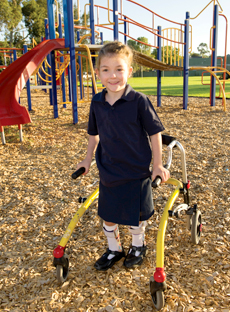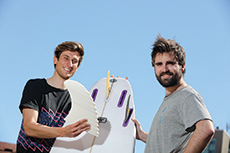Tech steps towards a new life

Seven-year-old Tanna - photo
courtesy of Novita Children's Services From helping children with special needs to walk, to revamping the BBQ and the surfboard, engineering students are applying their knowledge in exciting ways.
Some children with physical disabilities that affect walking need special care and attention to help them reach their full potential with mobility.
A team of Mechanical Engineering students, in partnership with Novita Children’s Services, is developing a special “exoskeleton” to help in the rehabilitation of children who have difficulty walking.
The exoskeleton was one of the hundreds of final-year projects on display at the recent Ingenuity expo for the University’s Faculty of Engineering, Computer and Mathematical Sciences.
“The exoskeleton is designed to provide clinicians with a repetitive and controlled rehabilitation system to use with their patients. It’s flexible enough to support a range of exercises aimed at correcting and strengthening a child’s walking pattern,” says project member Nathan Young.
“Our project aims to improve on current rehabilitation methods by including motion systems that help with the active control of the pelvis.”
In addition to the control system and mechanical design, the project team – involving students Yuming Huang, Zefeng Shao, Jiazhen Wang, Jiaqi Xiao and Yi Ying – will develop a computer-based simulation. This will help them to better understand the system’s operating parameters and possible responses of the patient during therapy.
“Anything we can do that will potentially help children to walk will be of great relief to many families,” Nathan says.

The Smart BBQ can cook a perfect steak
with the help of mobile technology Recooking the Aussie BBQ
It’s one thing to talk on your mobile phone while cooking a barbie, but what about using the phone itself to help cook the perfect steak?
University of Adelaide student Alex Tolson had this idea while looking for a technical challenge worthy of his final-year Mechanical Engineering project. Now in his fifth year of a double degree (also studying Finance), Alex realised there was no currently available barbecue that gave complete control over the temperature, and hence the cooking process.
The result is the Smart BBQ, which brings together a range of technologies to ensure that, no matter what their cooking ability, the user is able to become proficient in barbecuing.
“The Smart BBQ takes the guesswork out of cooking, enabling the user to cook to a higher standard,” says Alex, who has worked on the project this year with colleagues Alexander Pearce and Matthew Freeman.
“Combining temperature sensors on the BBQ with a smartphone interface, the user is able to control all cooking temperatures to within one degree. You even get notifications on your phone when it’s time to turn the meat,” he says.
One of the biggest technical snags faced by the team was managing the flow of gas. The gas valves they needed for the project were going to cost them $1000 and had to be imported from overseas. So instead, they made their own valves for just $60 each.
“Initially we thought this project was just a good technical challenge, but as we’ve got closer to the end of the year we’ve realised the Smart BBQ could really revolutionise the way people barbecue,” Alex says.

Aerospace Engineering students Isaac
Simionato and Nick Travers with one
of their new surfboard fin designs Surf's up
Aerospace Engineering students Isaac Simionato and Nick Travers are applying the same aerodynamics techniques they’ve learnt in the classroom to designing a better surfboard fin.
“The fin of a surfboard may not sound very space-aged, but essentially it has a wing shape, which is why our work fits in so neatly with this project,” says Isaac.
“Professional surfing is a rapidly growing sport and the performance of a surfboard is heavily reliant on its fin design and configuration. However, most surfboard fin designs are largely modelled on dolphin fins. There’s been little research and advancement made to current designs.”
Aircraft wings, yacht keels and rudders, even golf balls and marine animals have been used as inspiration for designs, taking into consideration the fluid mechanics of each. As well as modelling the performance of their test fins in computer simulations, the team has used wind tunnels to better understand the aerodynamics of both currently available and newly designed fins.
“So far, our new fin designs have shown great potential, providing a superior performance to standard fins in our testing,” Isaac says. As surfers themselves, no doubt Isaac and Nick will be keen to test their new fin designs for real – out among the waves.
|







